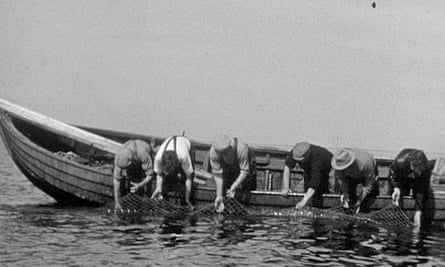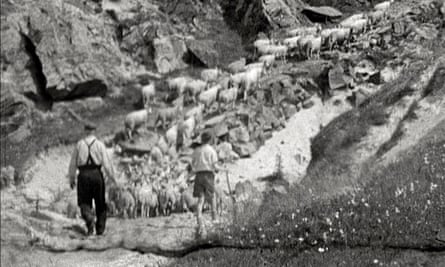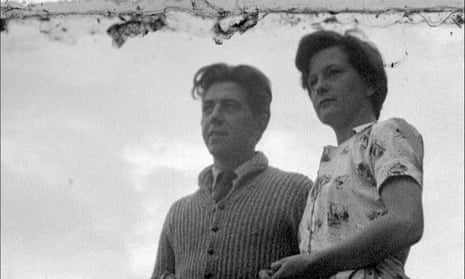An uncompleted film documenting the depopulation of the Scottish Highlands is to finally receive its premiere in Glasgow, 60 years after its creators abandoned its production.
Lost Treasure, recorded in 1956 by a pioneering socialist film-making collective linked to a film society in Clydebank, was intended to tell the story of Highland communities left empty and impoverished by migration to cities and the influence of powerful private landowners.
Filming came to a halt after 40 minutes of footage was recorded in July 1956 when the Glasgow-based Dawn Cine Group found itself unable to fund the film’s completion, leaving their raw, grainy, black and white film to lie unviewed.
The material has been stored by the Scottish Screen Archives since the 1970s, when it was handed in for preservation by one of the group’s members. It had apparently been stored in their garage. Now, six decades later, it will be shown to the public for the first time as part of the Glasgow Short Film Festival.
While the rediscovered footage was recorded without sound, the film’s script has survived, along with extensive notes on dialogue, music and English and Gaelic poetry that had been intended to accompany the images on screen. Its premiere will feature a soundtrack performed live during the screening by Edinburgh singer-songwriter Drew Wright and Hamish Brown of electronic pop band Swimmer One.
Organiser Matt Lloyd said the project, which saw around 40 minutes of raw footage pieced together by Finnish cinematographer Minttu Mäntynen, highlighted the divide between urban and rural communities in Scotland and the long-running debate on land ownership in the country.

It was shot largely in Sutherland, particularly at Achmelvich bay near Lochinver with some sections in Glasgow, he said.
It’s essentially a film that explores the collapsing population in the Highlands through a burgeoning love story between a crofter and a Glaswegian woman.
It was intended as a way of telling the story of the region through the mouths of its people, and it looks at the various ways people have been forced off the land in the Highlands, at family members who went south to work in the cities, or emigrated to Canada, or went off to war. Even today the Highlands are still suffering the effects of that lack of population and industry.
But he added that the film had an optimistic vision of the region’s future.
There’s some interesting footage of the construction of the Dounreay nuclear power station, and of hydroelectric systems being introduced. It was never intended as a nostalgia trip about the Highlands we lost, it has a vision of how to bring jobs and people back to the area.
Today we take a more conservationist view, but at the time it would have been seen as a very progressive approach. Older industries might not have been the best in terms of balancing jobs with ecology, but the equivalent today would be things like using wind and wave power to develop the Highland economy, so it’s very relevant to a modern audience.
Before beginning work on Lost Treasure, the Dawn Cine Group had found success with its earlier production Let Glasgow Flourish, which exposed overcrowded and filthy living conditions in the city’s slums.
Lloyd said the group, which was the production arm of the Clydeside Film Society and relied on its members and subscriptions, had been ahead of its time in an era when the cost of equipment was an insurmountable barrier to filmmaking for ordinary people.

The group were not part of the formal, state-sponsored documentary filmmaking world which was dominant in the 1950s and overseen by the Films of Scotland committee. That committee’s output was “dogmatic, instructive”, promoting state industries and industrial progress.
There were very few people with access to cameras in those days beyond people working in centralised studio systems and aristocrats who could afford to make their own home movies. There were state-funded documentaries, but this kind of oppositional filmmaking with socialist intentions was very rare.
The Dawn group held bring-and-buy sales and public lectures to raise the money to buy their camera. They filmed protests and demonstrations. Eventually they ran out of money, but their plans for Lost Treasure were really pretty epic, and it gives an indication of what Scottish filmmaking might have been if people had had access to
Brown said that while the techniques he and Wright had used on the soundtrack would have been completely alien to the film’s original creators, he hoped they had captured the atmosphere intended in the script.
We’re using a lot of modern equipment, we haven’t made an effort to be authentic to the technology or arrangements or instruments of the day. We’re looking to do an artistic response rather than purely revisiting original material.
He added that the film’s debut coincides with a push for land reform in Scotland, where campaigners argue that the consolidation of land in the hands of private owners has been detrimental to the communities living and working on it.
Historically, Highland crofters were among the first people to buy out their land from owners, even before the residents of Eigg, that’s part of what made this project quite attractive to me. It’s a very politically active region given how sparsely populated it is, and it’s a very interesting time to revisit some of the issues in the film.
After the debut in Glasgow we’ll be touring around the country, and I’m particularly excited about taking the film to the actual locations where it was shot.
- Lost Treasure will be shown on 16 March at the Glasgow Film Theatre, and will then tour Scottish cinemas this spring.

Comments (…)
Sign in or create your Guardian account to join the discussion